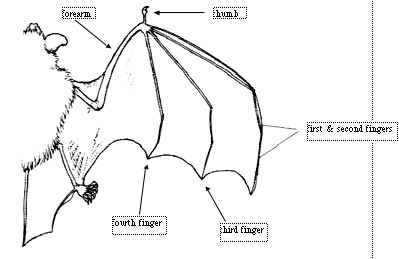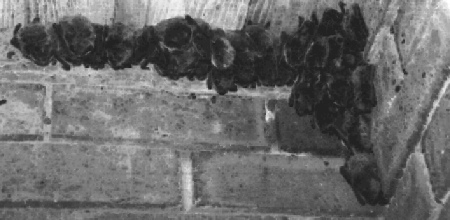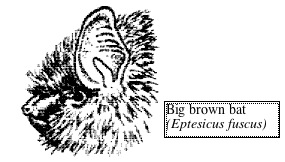Bats! Our Bug Eating Buddies!
(Bob Young, Bat Conservation Society of Canada)
Unless you are planning to be in the extreme polar, or desert regions of the earth in the near future, you will be in bat habitat! Bats, scientifically classified as ‘Chiroptera’ (meaning ‘hand-wing’) live all over the world. We often think that they don’t live near us, since we rarely interact with them, but they are there! Often mistaken as birds flying at night, we reap the benefits of their nocturnal habits, as they consume tons and tons of insects nightly. At Bracken Cave near Austin, Texas, one colony of female Mexican free-tailed bats, numbering 20 million individuals, consume the equivalent in weight of 23 Asian elephants... each night! Bats are probably the least understood, and most misunderstood of any mammal on the earth, but by the end of this article, you will be on your way to appreciating these shy, gentle animals of the night.
Many people believe many things about bats, not the least of which is that they get caught in your hair. There is not one documented case of this happening, yet this ridiculous myth persists. Bats certainly do come close to us as we enjoy the outdoors, but unless you look like an insect, you have nothing to fear! All bats in Canada are insectivorous, that is they eat insects. (There are no fruit bats here, except in captivity, usually in zoos). While wandering around outdoors, we stir up insects, as well as attract them due to our body heat and carbon dioxide emissions (from exhaling). The bats see the insects and swoop close by to catch them. Perhaps this is where the myth started. They may come so close as to even lightly brush by us as they catch their dinners, but humans offer nothing to bats, in terms of a food source. While teaching groups of people about bats, I have often placed a bat in an assistants’ hair, tangling it up as much as possible, then stepped away, only to see the scared little fellow flying off into the night before I can even get my hands down to my side!
Bats are not blind either. They see very well with their eyes, as well as being able to use sound to draw mental pictures of what is in front of them. They can’t see in colour, which makes sense, since it takes a lot of light in order to see in colour, and they are generally out and about during low light conditions! But it’s their echo-location abilities that make them fascinating. Using the same body part that you speak with - the larynx - bats shout aloud many times per second. The shouts are at a very high frequency - usually above 20 kilohertz and as high as 200 kHz. (We can hear up to 20 kHz.). When the sound returns to the bat, they are able to determine what the sound has bounced off. When they do this enough times (up to 200 times per second!) they know what is in front of them, whether it is tasty or not, what direction it is moving, then they can plan an intercept track, in order to catch the bug! All this while flying in the dark, and having an effective range of only 2 meters! Try it yourself! Shout out loud as you walk around your house in the dark. As you approach a wall, you well begin to hear the echo from the wall, and if you practice enough, you’ll be able to stop before flattening your face!
Now that we’ve dealt with the two main myths about bats, let’s look at some of the more fascinating things about these animals. Bats are mammals: they are born alive, they nurse milk from their mother, they have hair, two sets of teeth (baby and adult), they are warm blooded, they breathe air, and they have appendages! Associated with air intake, is a diaphragm, a four chambered heart, and an advanced central nervous system. Probably the most interesting aspect of a bat, is their ability to fly. They are the ONLY mammal capable of sustaining flight. It would appear that they discovered this ability a long time ago, since bats are virtually unchanged in the past 50 million years! A close look at a bats wing, shows that they fly using their hands. The upper arm, elbow, and forearm are clearly visible in the diagram below.

Notice the thumb, and four fingers, very similar to our hands, except that their fingers are much longer. Growing between the fingers is skin. This is often referred to as webbing, but more correctly it would be called membrane. It’s about the same thickness as a plastic sandwich bag, and about the same strength. Try pushing your finger through a sandwich bag, and you’ll see how strong it is! Bats are excellent fliers! It might not seem so as you watch them flitting about at night, but recall the explanation above about echo-location. Consider that the bat is echo-locating on bugs, who are moving around in a three dimensional space, and the fact that the bat only has approximately two meters in which to contact the insect, make good it’s intercept track, and then react to the direction of travel of the insect, you will realize just how good an aviator the bat truly is! So while they appear to be flitting around, they are actually out-performing ANY aerobatic maneuver ever attempted by man in our clumsy flying machines!
There are close to a 1000 species of bats worldwide, making them the second largest group of mammals. That means that almost 25% of all mammals on the planet are bats! Most bat species live in the tropical regions of the world. There are approximately 175 species of fruit bats, who are responsible for 95% of the seed dispersal of the world’s rain forests. They eat the fruit of the trees, fly away, and 15 minutes after eating, deposit the undigested seeds where ever they happen to be flying! Nectar feeding bats are responsible for the pollination of many valuable fruits, trees and plants that are important to us. Remember to thank bats the next time you eat a banana, mango, fig, date, avocado, or enjoy a margarita on the beaches of Mexico! Life jackets (they used to be filled with kapok to make them float - which comes from the kapok tree), balsa wood and over 400 other plants rely on bats for pollination.
Other types of food that bats eat include meat. The frog eating bat for example, uses the sound of male frogs looking for mates, in order to home in on their dinner. This is one example of the danger of shouting out for a mate!
Probably the most famous bat, is the blood eating vampire. There are three types of vampires that eat blood. Only one of these three, eat blood from mammals, the other two eat blood from birds. Vampires live along the ocean coasts of Mexico, south into central America, and down into South America. They account for about 0.3% of the total number of bats. They are about the same size as a Big brown bat, and use their sensitive noses to determine the place where a vein comes closest to the surface. Using very sharp incisor teeth, they make a small nip and begin to lick. In their saliva, is an anti-coagulant, that allows the blood to flow as long as they continue to eat. They will eat up to 20 ml of blood, then return to their roost. An interesting fact about Vampires, is their willingness to share food with other members of their roost, who may not have successfully found food! Even the Vampire bat will prove valuable to man, once we are able to replicate the anti-coagulant, and administer it to people suffering from coronary heart disease!
Here in Canada, there are 9 species of bats found in Alberta and Ontario, eight in Saskatchewan and Quebec, seven in New Brunswick, 6 in Manitoba, and Nova Scotia, and less than 4 in the other provinces, except in B.C. where a total of 17 species have been identified! All of these bats are insectivorous, consuming up to 100% of their body weight each night in insects. That works out to about 500 mosquito sized insects per hour!
The two species of bats that we are most likely to come into contact with, in Canada, are the Little brown bat (Myotis lucifugus), and the big brown bat (Eptesicus fuscus).
The Little brown bat is the most common in Canada, and lives up to 33 years, making them the longest living mammal for their size in the world! They typically have only one baby per year (called a pup), and are able to recognize their pup when they return from hunting trips, even though there may be millions of other babies crying for their moms - all in the same cave! Imagine finding your child in a mall full of screaming kids!

A hangar of little brown bats; 80% of these female bats were expecting!
The Big brown bat likes to live in the attics of human buildings. Since energy conservation is so important to the survival of a bat (they are true hibernators - spending as many as 8 months sleeping), they look for roosts that provide lots of humid heat. In this way, they do not use up energy trying to stay warm. It’s been said that there are more Big brown bats in Edmonton during the winter, than there are during the summer!

Identifying these two types bats is fairly simple once you have seen them side by side. Otherwise it’s not so easy! Little brown’s have a wing span of about 270 mm, and weigh about 8 grams, while big brown’s have a wing span of close to 350 mm, and weigh up to 27 grams. They both have beautiful, soft coats of brown coloured fur, with black arms, wings and tail membranes.
Some bat species of Canada, don’t stay here all winter. Silver hair bats, red bats, and hoary bats for example, migrate south to warmer climates. The bats that do remain, go into deep sleep, called hibernation. While hibernating, the heart rates of these bats slow to low as 24 beats per minute (little brown)! Oxygen consumption decreases by as much as 1/100 of normal resting amount required. Some scientists are studying bats ability to hibernate, since space travel for humans will likely require our ability to reduce our oxygen consumption, and decrease our heart rates, in order to survive long periods of time during space travel!
If you have continued to read to this point, you will have probably gained a deeper understanding and tolerance for bats. But I can’t blame you if you’re not willing to share your house and attic with them! Unlike rodents, bats are not destructive in that they do not chew things, or make nests in insulation. They do however, make lots of noise, and are not the best house guests when it comes to using the bathroom! Fortunately, it is fairly simple to get rid of them, without hurting them. The first thing to do is to discover where they are gaining access. This can be done by looking for their feces on the side of the building, or on the ground. They often relieve themselves, as they enter or exit. You can also watch for stains in the area of the entrance/exit, caused from the oils on their skin. Finally, you can have some friends over, and stand at the corners of the house as night falls, and watch where they come out. Once discovered, simply cover the hole with some screening, taping the top and two sides with duct tape, leaving the bottom of the screen extending 8 to 12 inches below the hole, untaped. When the bats leave in the evening, they will crawl to the bottom of the screen, and leave. When they return, they will not be able to figure out how to get back in, and will look for another place to live! Considering the benefit of having bats around your residence, you may want to place a ‘bat house’ in the vicinity of the hole, in the hopes that they will move into the bat house, and still be around to eat all those insects! Once the bats have been evicted from the attic, simply fill the hole with putty or silicone, and the bat problem will be solved! It is very important to NOT do the eviction from mid-June to the end of August, as this is when the babies will be around. Imagine your panic if your were not able to return to your child, and the corresponding results, and you will understand why. (Bat house plans and advice are available free of charge from the Bat Conservation Society of Canada).
When a bat decides to enter your house, there are a number of options that you can choose. What often happens, is the human resident of the house goes berserk, standing in the middle of the room, screaming and lashing out with whatever weapon is within reach. Imagine for a moment your reaction if you stumbled into the house of another species of animal that was 500 times larger than you, and it began to scream and throw things at you! I suspect that these actions might disturb you! The best thing to do, is to open the windows and doors to the outside, close doors leading to another part of the house, and sit down. Enjoy watching the bat flying around, and marvel at its ability to do wing overs, hammerheads, and tight turns. Eventually, the bat will tire, land on the wall, and if you stay still, it will go to sleep. Quietly approach this timid little bat, and while wearing gloves, gently grab it, take it outside, and set it on a tree. Your new friend will likely disappear into the night, and you will both be relieved to have the experience over with!
Finally, one issue that must be dealt with is the fear that many people have about rabid bats. All mammals are capable of contracting rabies, which is a fatal disease. Bats are not an exception, however, once the virus becomes active, the bat will soon die. Bats are NOT asymtematic carriers of rabies. Fortunately, when bats become rabid, they generally are not aggressive, unlike some other animals. If however, a rabid bat is handled, it will bite in self-defence, and may pass on the disease. Treatment is no longer the painful series of inter muscular needles it used to be. There is now available a vaccination that is received in the arm, that result in flu like symptoms for a short period of time. For those of you who are interested, a recent Canada wide rabies report from Animal Health Division of Food Production and Inspection Branch of Agriculture Canada, showed 14 rabid skunks, 6 rabid foxes, 6 rabid cows, two rabid dogs, one each of rabid horse, goat and bat. To keep this in perspective, there have been only 3 human deaths in Canada in history, yet between 1984 and 1992, there were 38 people killed by lightening strikes! Be cautious of unusual behaviour of bats. A bat lying on the ground is displaying unusual behaviour, but it does not mean that the animal is rabid. It may be a very tired juvenile. To protect other animals and children, simply put on a pair of thick gloves, gently, but firmly pick up the bat, place it on a tree, and walk away. The bottom line is to simply, physically leave bats alone, and you are more likely to die from being hit by lightening!
Bats play an important role in our lives. A colony of 150 Big brown bats could easily consume 38000 cucumber beetles, 16000 May and June bugs, 19000 Stinkbugs and 50000 Leafhoppers in one summer! Those cucumber beetles would have produced 18 million corn rootworms, which would have destroyed 10 to 13% of the total corn produced! And the feces (called guano) of those bats can be sold as an excellent natural fertilizer for house gardens! Unfortunately, it is estimated that 40% of the bats of the United States and Canada, are threatened or endangered with extinction, primarily due to unfounded human prejudice. Our responsibility is to share our habitat, and to ensure that all other species of flora and fauna have a place to live. As you have seen, bats are an important part of our world!